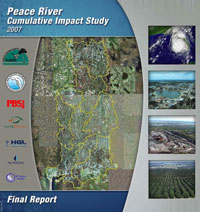The Peace River Cumulative Impact Study
In 2003, the Florida State Legislature directed the Department of Environmental Protection and the Southwest Florida Water Management District to study the Peace River basin. This was to be done by analyzing the cumulative impacts that mining, development and agriculture on the area. A major focus of this study was:
- The impacts on ground and surface water, estuaries and wetlands.
- Effectiveness of existing programs in managing the impacts.
- Recommendation for future management of the Peace River Basin.
The results of the study were sobering. More than 343 miles of streams had been lost since the 1940's. Approximately 38 percent of the wetlands had disappeared—including a loss of 31,000 acres after the wetland regulations of 1979. Aquifers had dropped from 20-50 feet, and the water supply in adjacent Punta Gorda had been mineralized by salt-laden run-off water from mining. A combination of phosphate, agriculture, and development was responsible for these impacts. However, mining has had the biggest impact.
- Though phosphate accounted for only 10 percent of the total land-use, it accounted for 43 percent of the total loss in wetlands.
- Phosphate was the largest single 1999 land use that occurred in the place of former natural stream channels, and accounted for 30 percent of stream loss (105.2 miles).
The Peace River Cumulative Impact study gave us a good indication of the extent and cause of impacts to the basin. The next step should have been to create a management program to address those impacts directly. Unfortunately, the new management plan fell short. Instead of recognizing the need for new programs and regulations, it suggested that existing programs are sufficient.
The Future
We need to understand the impact, but we also need to repair the damage. Reclamation has failed and the result in clear in reduced water flows and degraded water quality.
The Peace River Cumulative Impact Study was a good start, but it is only a start. Mosaic Phosphate owns the mineral rights to 443,000 acres of land in central Florida. They plan to mine 140,000-170,000 acres of that land over the next 30 years, though there is no plan available to local governments or the public.
What is needed is an area-wide Cumulative Impact Study. We need to take into account the past, present and future mining operations. We need to know how continued mining will affect wildlife, water supplies, and the economy.
We need to look beyond the local areas and find out how phosphate impacts ecosystems downstream and into the Gulf of Mexico.
The Peace River and Charlotte Harbor are at the heart of the quality of life and economic vitality of the region. They must be protected.
